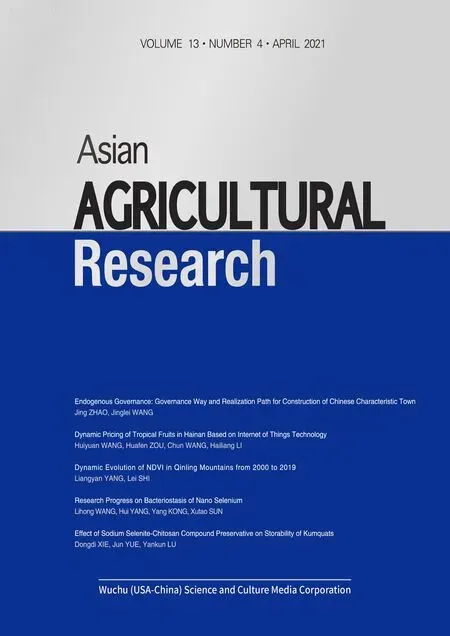Effect of Sodium Selenite-Chitosan Compound Preservative on Storability of Kumquats
2021-07-01DongdiXIEJunYUEYankunLU
Dongdi XIE, Jun YUE, Yankun LU
1. Department of Chemical and Biological Engineer, Hezhou University, Hezhou 542899, China; 2. Library of Hezhou University, Hezhou 542899, China
Abstract [Objectives] To explore the effect of sodium selenite-chitosan compound preservative on storability of kumquats. [Methods] Under the condition of room temperature, fresh kumquats were coated with different concentrations of sodium selenite-chitosan compound preservative, respectively. [Results] Sodium selenite-chitosan compound preservative reduced the weight loss rate, delayed the decline of vitamin C, soluble solids, titratable acid and GSH contents, slowed down the accumulation of MDA, inhibited the increase of PPO activity, and increased to a certain extent the activity of SOD in fresh kumquats. [Conclusions] Sodium selenite-chitosan compound preservative maintained the quality and prolonged the shelf life of kumquats. The preservation effect of compound preservative composed of 4 mg/L sodium selenite and 8 g/L chitosan was the best.
Key words Kumquat, Sodium selenite, Chitosan, Storage quality
1 Introduction
Kumquat, also known as Jingan and Jintan, belong to Fortunella in Aurantioidae of Rutaceae. It has bright color and favorable taste, and its peel and flesh can be eaten simultaneously. Kumquat is a kind of fruit for both medicine and food, and is deeply loved by people. It is native to southern China, and has been cultivated for more then 1 700 years. At present, kumquat is mainly planted in Jiangxi, Fujian, Guangdong and Guangxi, with a wide range and large area. Kumquats are small in size and thin in peel, susceptible to penicilliosis and green mold after harvest, and easy to lose water, wither, rot and deteriorate during storage, transportation and sales process, leading to reduction or loss of nutritional value and edible value and short shelf life. Therefore, reducing the loss of kumquats in the process of storage and transportation is an urgent problem. Most of the current researches are based on single preservative, while compound preservative is rarely reported in kumquats.
Selenium is an important element in life. In 1973, the World Health Organization confirmed that selenium is one of the essential trace elements in human and animals. It is widely used in production and life. There are more and more researches on selenium in the aspect of preservation. Wu Jie, Gao Chunliet
al.
and Zhang Haiyingtreated tomato, apricot, peach, winter jujube and strawberry with selenium, respectively, and fully confirmed that selenium treatment could improve the resistance and delay the senescence process of fruit.Chitosan (CTS) is also called deacetylated chitin. Chitin was first extracted from crustaceans (shrimps and crabs). After a series of deacetylation, an alkaline polysaccharide is obtained. Chitosan has excellent film-forming property, and coating it on the surface of fruits and vegetables can inhibit the respiratory intensity, prevent the evaporation of water, slow down the aging of cells, and prolong the storage life of fruits and vegetables. Currently, a lot of researches have been done on the application of chitosan in fruit and vegetable preservation.
In this study, at room temperature, different concentrations of sodium selenite-chitosan compound preservative was coated on the surface of kumquats, and the effect on the storability of kumquats was analyzed, in order to reduce the loss of kumquats in the process of storage and transportation.
2 Materials and methods
2.1 Materials
2.1.1
Fruits. Fresh and damaged kumquats, picked on the day of sample collection, with uniform size and moderate maturity were purchased from Hezhou Sisters’ Fruit Store as the test material.2.1.2
Reagents and drugs. The reagents and drugs used mainly included chitosan (BC, Sinopharm Chemical Reagent Co., Ltd.), sodium selenite, ascorbic acid, 2-thiobarbituric acid, L-methionine (AR, Shandong Xiya Chemical Industry Co., Ltd.), 2,6-dichloroindophenol sodium salt hydrate, azotetrazole, riboflavin, dithiobisnitrobenzoic acid and glutathione (AR, Sangon Biotech (Shanghai) Co., Ltd.).2.1.3
Instruments and equipment. The instruments and equipment used mainly included PAl-1 digital handheld pocket refractometer (PAl-1, ATAGO), ultraviolet visible spectrophotometer (722, Shanghai Youke Instrument Co., Ltd.), high-speed and large-capacity electric centrifuge (YXJ-A, Jiangsu Jintan Huanyu Scientific Instrument Factory) and electronic balance (JJ500, Changshu Shuangjie Test Instrument Factory).2.2 Methods
2.2.1
Experimental design. Sodium selenite solution and chitosan solution were used to pretreat kumquats to determine their suitable ranges for compound preservative experiment. Three concentrations were designed for sodium selenite solution: 4, 6 and 8 mg/L; and two concentrations were designed for chitosan solution: 6 and 8 g/L. The kumquats were randomly divided into seven groups: treatment 1 (4 mg/L+6 g/L), treatment 2 (6 mg/L+6 g/L), treatment 3 (8 mg/L+6 g/L), treatment 4 (4 mg/L+8 g/L), treatment 5 (6 mg/L+8 g/L), treatment 6 (8 mg/L+8 g/L) and control (CK, distilled water). After soaking for 1 min, the kumquats were taken out, put in a basket, air-dried, and stored at room temperature. Sampling was performed once every 5 d for evaluation of sensory quality and determination of weight loss rate, soluble solids content, titratable acid content, vitamin C content, PPO activity, SOD activity, MDA content and GSH content, to investigate the effect of the compound preservative on the storability of kumquats.2.2.2
Sensory evaluation. Based on the color, appearance, smell, texture and taste of kumquats, the evaluation criteria were determined (Table 1). Ten teachers and students of food specialty were invited to carry out sensory evaluation and score, 1-5 points for the score. Average value was calculated as the result, and the preservation effect during storage was recorded.
Table 1 Sensory evaluation criteria for kumquats
2.2.3
Determination of physical and chemical indexes. Weight loss rate was measured by weighing method. Soluble solids content was measured with a hand-held refractometer. Titratable acid content was determined by acid-base titration method. Vitamin C content was determined by 2,6-dichlorophenol indophenol titration method. Polyphenol oxidase (PPO) activity was determined with catechol spectrophotometry with reference to Cao Jiankang. Superoxide dismutase (SOD) activity was determined with nitroblue tetrazolium photoreduction method, referring to Li Hesheng’s method. Malondialdehyde (MDA) content was determined by spectrophotometry, according to Li Hesheng’s method. Glutathione (GSH) content was determined by spectrophotometry with reference to Guo Wenlan’s method.3 Results and analysis
3.1 Effect on sensory evaluation indexes
With the extension of storage period, the score of sensory evaluation of kumquats showed a downward trend. The overall sensory quality of kumquats treated with compound preservative solution was better than that of CK group, suggesting that the preservative had obvious protective effect on kumquats. After 10 d of storage, the sensory score of treatment 4 maintained a relatively high level. After 20 d of storage, the sensory score was 3.8 points, the peel of the fruits remained smooth and glossy, with aroma, and the taste was more favorable. On day 20 of storage, the sensory score of the CK group was only 2.3 points (Fig.1), and the kumquats shrank and lost the commercial value.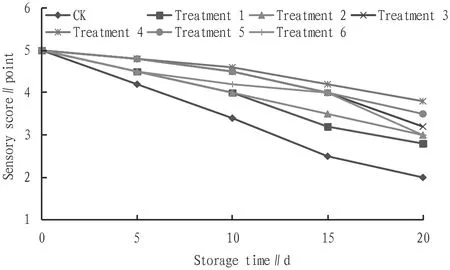
Fig.1 Effect of sodium selenite-chitosan compound preservative on sensory quality of kumquats
3.2 Effect on weight loss rate
Weight loss rate is an important index to measure the storage quality of fruits and vegetables. If fruits and vegetables lose too much water, they will shrink, wither and wilt. As shown in Fig.2, as the storage period extended, the kumquats of all the groups showed the phenomenon of water loss. The weight loss rate of the kumquats treated with compound preservative was lower than that of CK, indicating that the compound preservative slowed down the water loss of kumquats to a certain extent and played the role of keeping freshness. After 15 d of storage, the weight loss rate of treatment 3 was lower than those of the other groups, indicating that treatment 4 could better retain the water at the later stage of storage and keep good appearance quality of kumquats.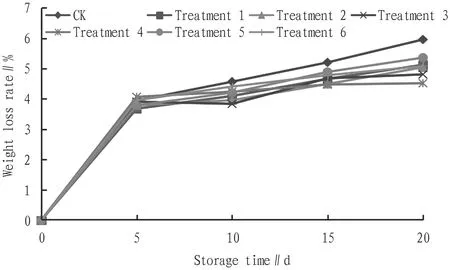
Fig.2 Effect of sodium selenite-chitosan compound preservative on weight loss rate of kumquats
3.3 Effect on soluble solids content
Soluble solids refer to water-soluble substances such as sugar, minerals and vitamins. The level of soluble solids can be used as one of the indexes to judge the quality of fruits. Fig.3 shows that the soluble solids content of kumquats increased in the early stage and decreased in the middle stage of storage. In the first 10 d of storage, as the fruits were still in a post ripening stage, the decline in soluble solids content of each treatment group was milder than that of CK. The peak value of treatment 4, treatment 5 and treatment 6 was one week later than that of other treatment groups, indicating that the preservative had a good effect on kumquat preservation. On day 20 of storage, the soluble solids contents of treatment 3 and treatment 4 were higher than those of the other treatment groups, indicating relatively good preservation effect.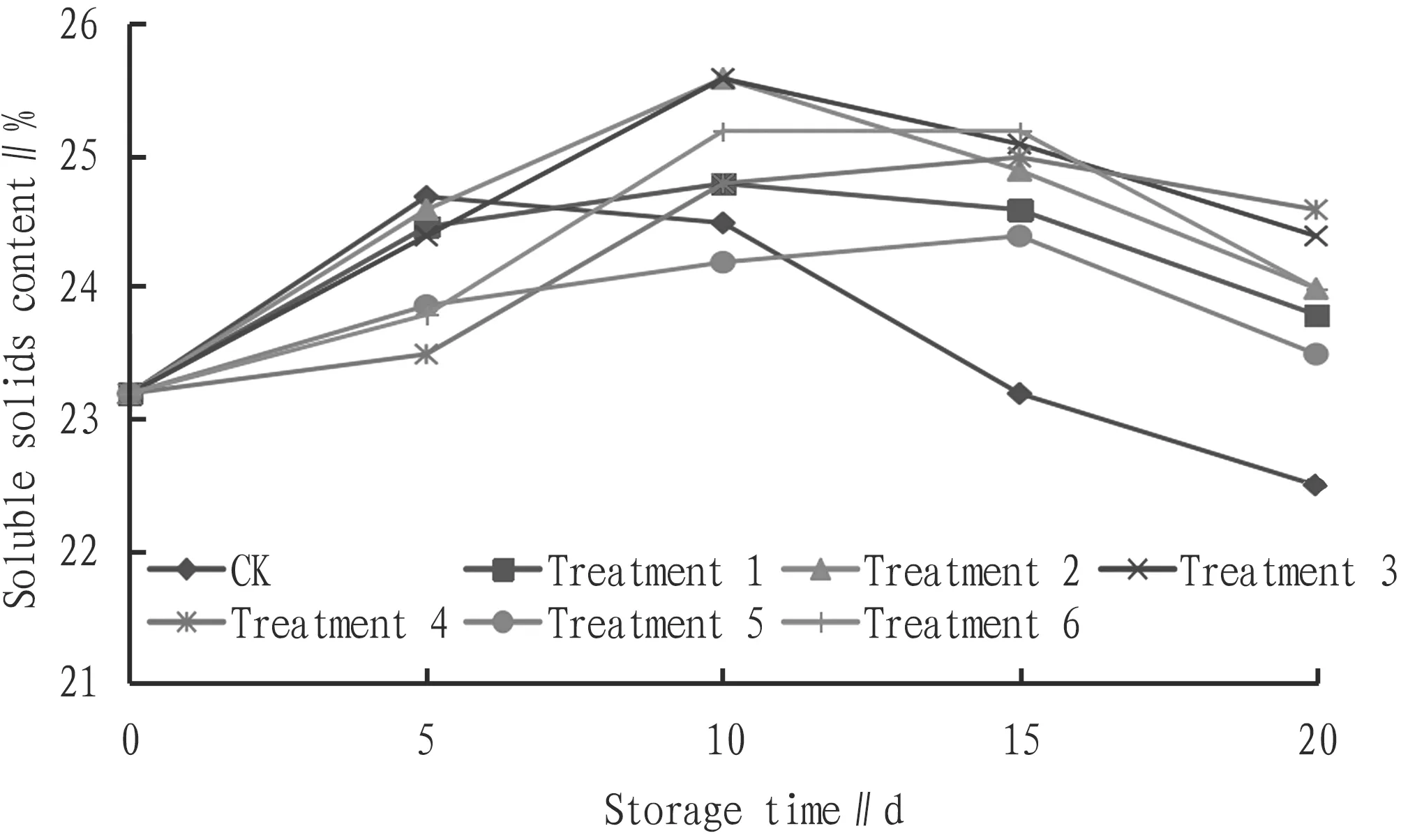
Fig.3 Effect of sodium selenite-chitosan compound preservative on soluble solids content of kumquats
3.4 Effect on titratable acid content
The main component of titratable acid is organic acid, and the content of organic acid has an important effect on fruit flavor during storage. As shown in Fig.4, the titratable acid content increased first and then decreased overall. After 15 d of storage, the titratable acid contents of kumquats treated with compound preservative were significantly higher than that of CK. The peak of titratable acid content in treatment 3 and 4 was later than that in other groups on day 10. The titratable acid content of treatment 4 was higher than those of other treatments throughout the storage period, indicating that treatment 4 obviously inhibited the degradation of organic acid and had good preservation effect.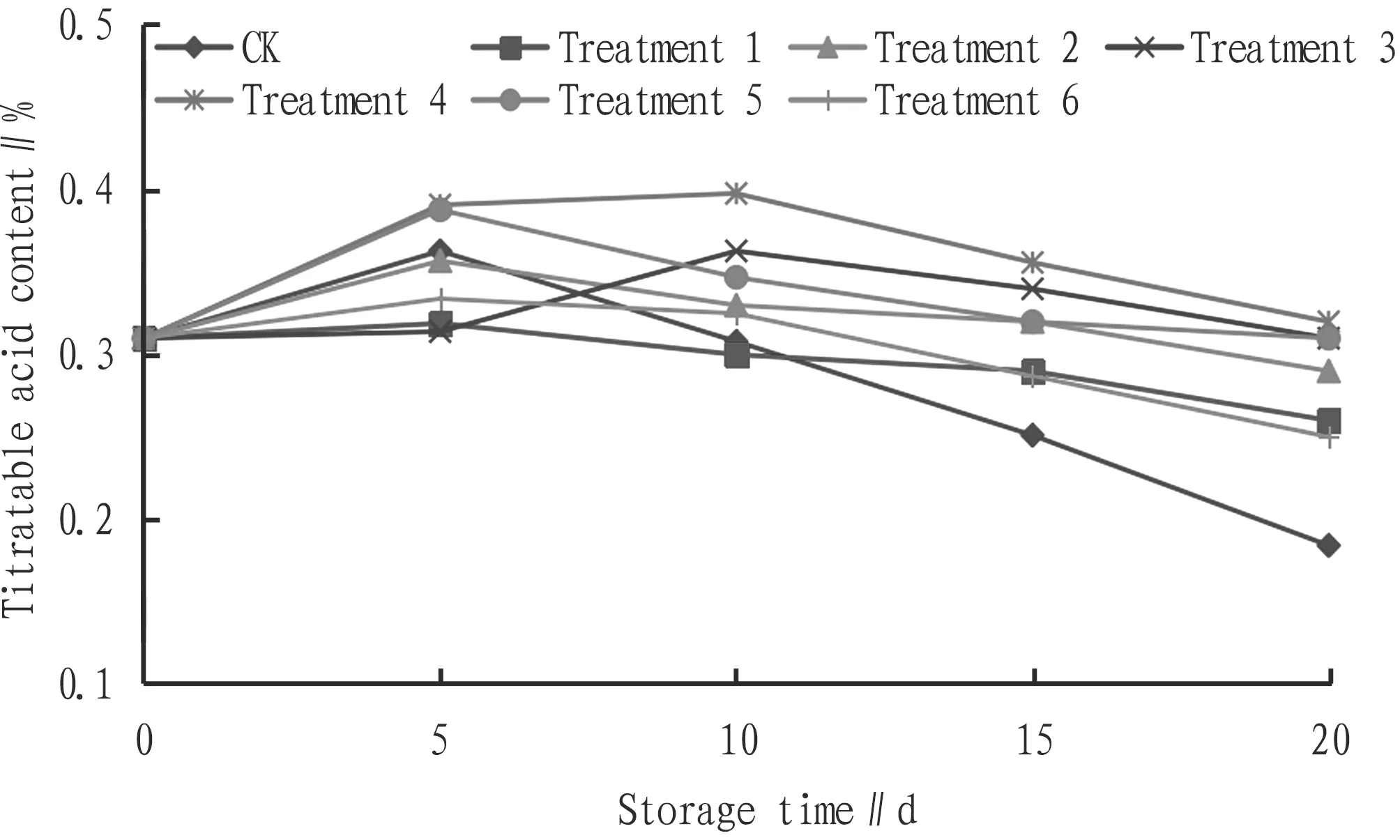
Fig.4 Effect of sodium selenite-chitosan compound preservative on titratable acid content of kumquats
3.5 Effect on vitamin C content
Vitamin C, also known as ascorbic acid, widely exists in fresh fruits and vegetables. It has the function of anti-aging and anti adversity for the storage of fruits and vegetables. As can be seen from Fig.5, the vitamin C content of all the treatment groups showed a downward trend. The vitamin C content of kumquats treated with compound preservative decreased more slowly than that of CK. On day 20 of storage, the vitamin C content of treatment 4 was 17.64 mg/100 g, while that of CK was only 11.06 mg/100 g. In summary, treatment 4 could maintain vitamin C in kumquats better.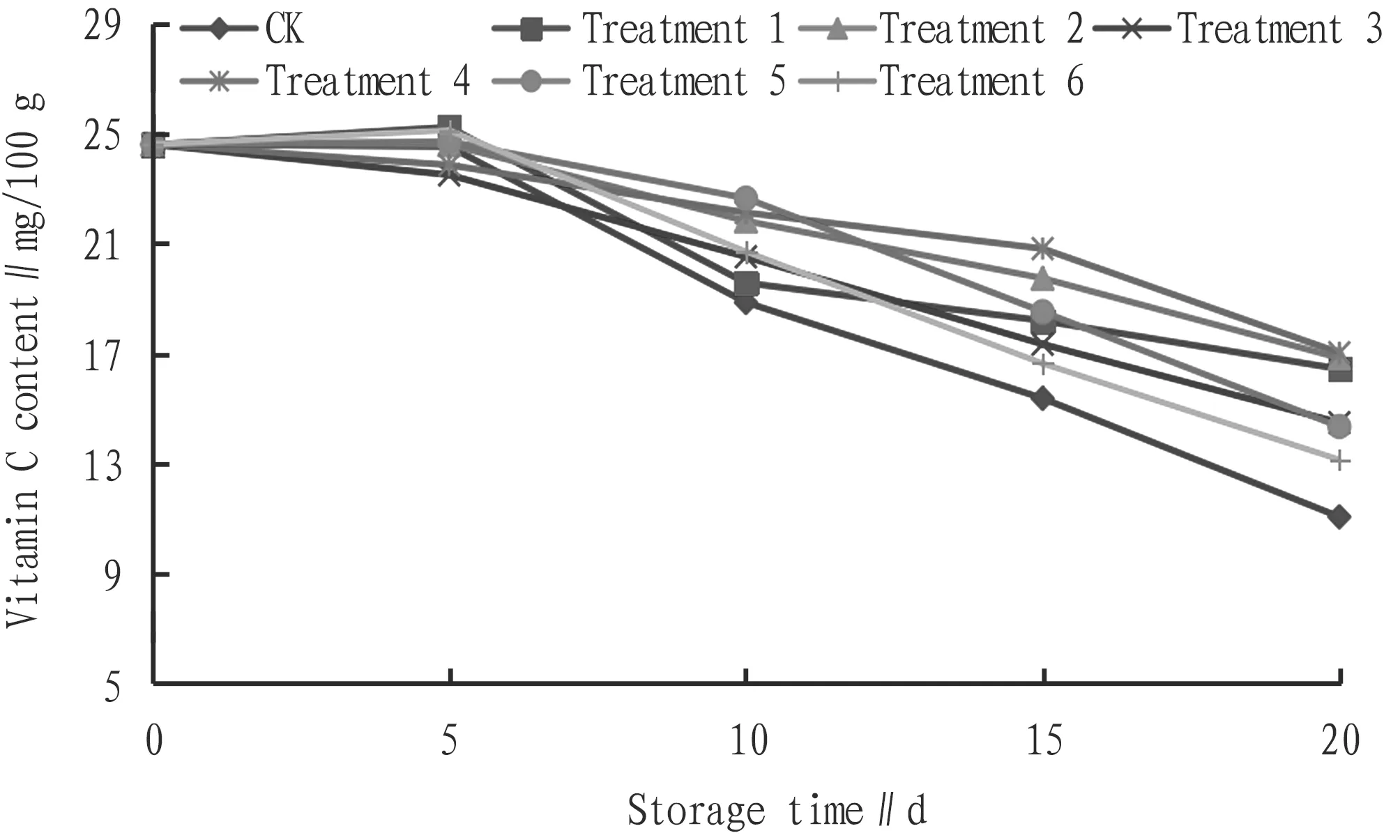
Fig.5 Effect of sodium selenite-chitosan compound preservative on vitamin C content of kumquats
3.6 Effect on PPO activity
Polyphenol oxidase (PPO) is one of the key enzymes leading to pigment changes in fruits and vegetables, affecting the appearance and flavor of fruits. It plays a key role in the metabolism of phenols. The higher the activity of PPO, the faster the degradation of phenols, and the weaker the antioxidant capacity of fruits. As shown in Fig.6, the PPO activity of kumquats decreased after treated with compound preservative. After 10 d of storage, as the storage period further extended, the PPO activity of kumquats in the treatment groups increased in different degrees as they were in the process of senescence. The PPO activity of treatment 4 and treatment 5 was 2.32 and 2.54 U/mL, respectively, significantly lower than that of CK, indicating that the compound preservative of treatment 4 and treatment 5 could effectively inhibit the activity of PPO in kumquats.
Fig.6 Effect of sodium selenite-chitosan compound preservative on PPO activity of kumquats
3.7 Effect on MDA content
Malondialdehyde (MDA) is an intermediate product of membrane lipid peroxidation. The generation of a lot of free radicals will affect the normal physiological metabolism of fruits. MDA content can be used as an indicator to measure the degree of membrane lipid peroxidation. Membrane lipid peroxidation directly leads to the destruction of cell membrane structure and the increase of permeability, causing fruit softening. The MDA content of kumquats treated with compound preservative was significantly lower than that of CK (Fig.7), indicating that sodium selenite-chitosan compound preservative could inhibit the accumulation of MDA in kumquats. The inhibition effect of treatment 3 and 4 was more obvious than that of other treatment groups. The content of MDA in treatment 4 remained at a reduced level, similar to the finding of Wu Jieon tomato.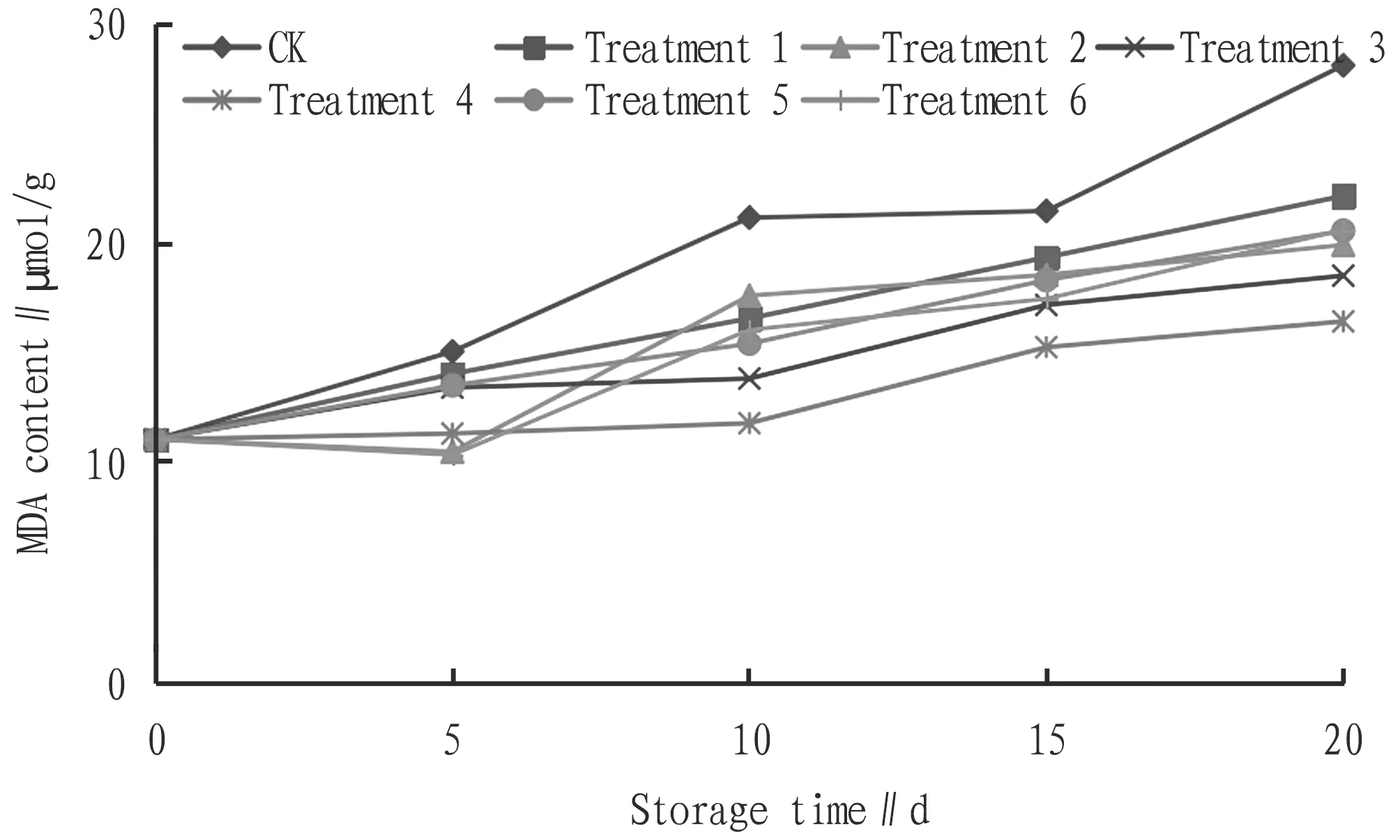
Fig.7 Effect of sodium selenite-chitosan compound preservative on MDA content of kumquats
3.8 Effect on SOD activity
Superoxide dismutase (SOD) is one of the protective enzymes in organisms. It exists widely in organisms, and has the function of scavenging free radicals, thereby slowing down senescence and resisting diseases in fruit storage. As shown in Fig.8, the SOD activity of kumquats treatment with compound preservative rose first and then declined. After 10 d of storage, as the fruits continued to age, the SOD activity began to decline. On day 15, the SOD activity of treatment 4 was higher than that of other treatment groups, indicating that appropriate concentration of compound preservative was beneficial to slowing down the senescence of kumquat cells.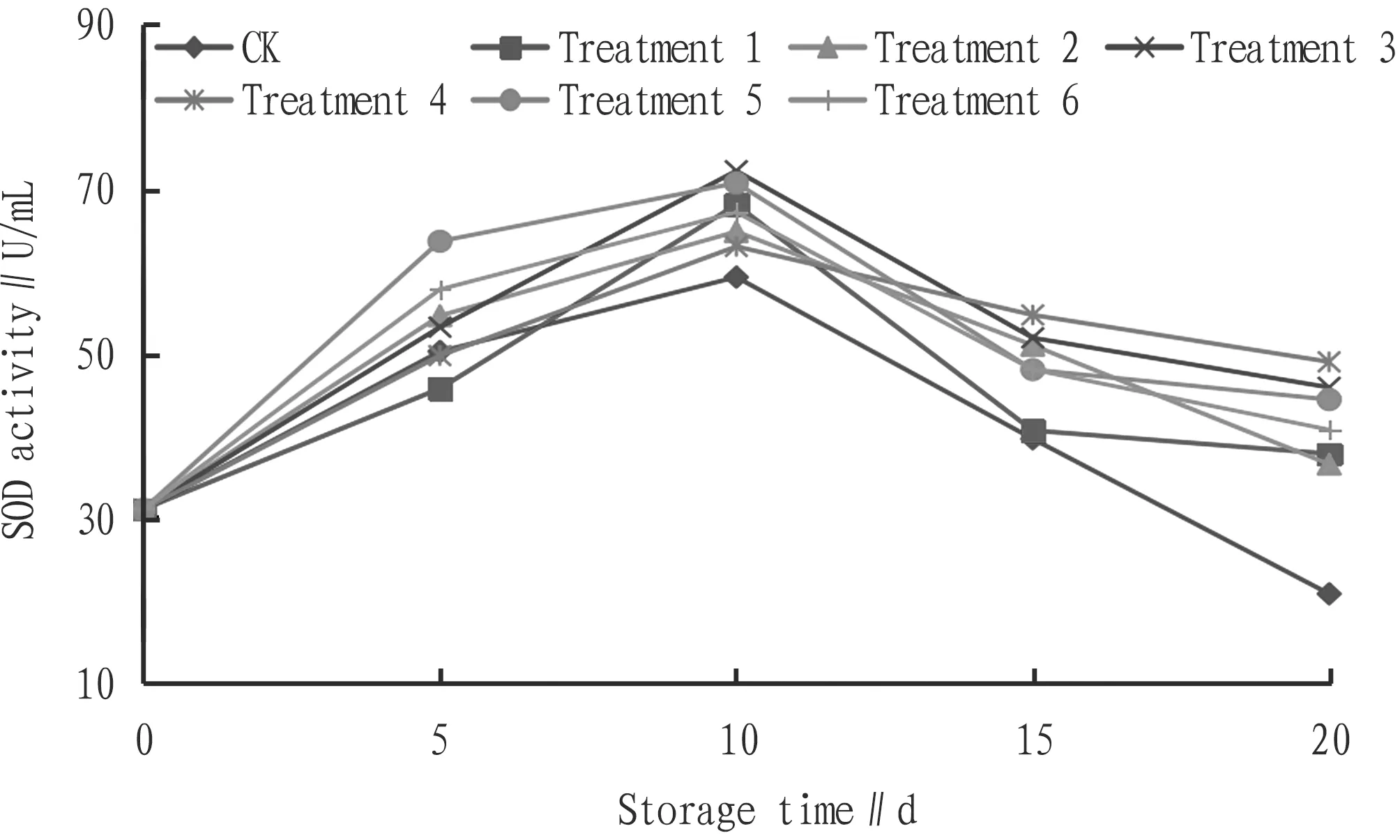
Fig.8 Effect of sodium selenite-chitosan compound preservative on SOD activity of kumquats
3.9 Effect on GSH content
Glutathione (GSH) is an important antioxidant in plant cells. It can reduce S-S bond to -SH, protect and stabilize the -SH group in protein and enzyme molecules, and play an important role in maintaining the integrity of membrane structure. The decline in GSH content indicates the entering into the aging process. As the storage time went on, the content of GSH in kumquats decreased gradually, and the content of GSH in treatments 1-5 was always higher than that in CK. On day 20 of storage, the GSH contents of treatments 3-5 were 42.78, 43.75 and 40.32 μmol/g, respectively (Fig.9), maintaining at a relatively high level, so that the quality of kumquats was better maintained. The reason might be that selenium acted in the form of GSH-Px and removed lipid peroxide and organic hydroperoxides in cells, thus playing an antioxidant role and protecting cells and tissues from damage of peroxides. Chitosan formed a protective film on the surface of the fruits, which reduced the damage of oxidation to kumquats and maintained the stability of antioxidant enzyme system. The results show that appropriate concentration of compound preservative had synchronous effect on MDA content of kumquats with Section3
.7
.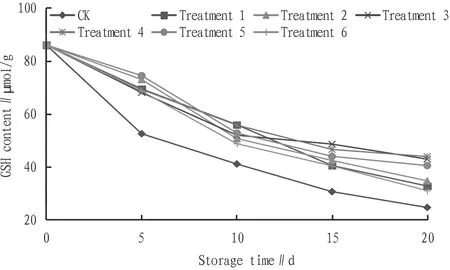
Fig.9 Effect of sodium selenite-chitosan compound preservative on GSH content of kumquats
4 Conclusions
In treatment 4, the kumquats could still maintain good color, appearance, flavor, taste and texture at room temperature; the evaporation of the kumquats was effectively reduced, so the fruits showed good water holding capacity; the decrease of soluble solids content, titratable acid content and vitamin C content of the kumquats was significantly slowed down; the consumption of substrate was effectively inhibited; the PPO activity was well inhibited; the accumulation of MDA was reduced; the activity of SOD was increased; and the content of GSH was kept high. As a result, the storability of the kumquats, as well as their edible value and commercial value, was improved.
杂志排行
Asian Agricultural Research的其它文章
- Comprehensive Construction of Innovative Talent Cultivating Model in Colleges and Universities
- Application of Big Data in the Remediation of Contaminated Sites
- Advances in Research on Effect of Heavy Metals Cd and Pb on Wheat and Mitigation Effect of Conditioners
- Breeding of Jingdan 15, a New Stress-resistant and High-yield Maize Cultivar
- Endogenous Governance: Governance Way and Realization Path for Construction of Chinese Characteristic Town
- Technique for Using Spent Mushroom Substrate of Flammulina velutipes to Cultivate Volvariella volvacea in Idle Period of Greenhouse Summer Squash
